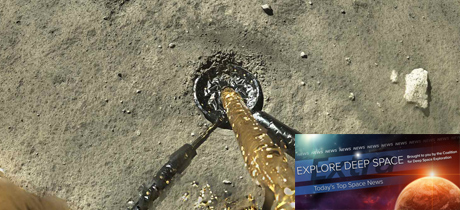In Today’s Deep Space Extra… The Perseverance rover and the Mission Extension Vehicle-1 (MEV-1) are among the greatest space innovations of 2020. Former NASA astronaut Mark Kelly has been sworn in as a U.S. Senator from Arizona.
Human Space Exploration
How Boeing is building the world’s most powerful deep-space rocket
Coalition Member in the News – Boeing
CNET (12/2): The Space Launch System (SLS) promises to become NASA’s most powerful rocket ever. The rocket’s primary mission is to launch astronauts and cargo to the Moon, then support human missions to Mars. The SLS includes an ability to launch large pre-assembled payloads to deep space.
Space Science
On Mars, internal heat may have powered habitable hotspots long ago
Space.com (12/2): According to a new study, the Martian underground may have been habitable billions of years ago even if the planet’s surface was dry, thanks to a favorable source of internal heat. NASA’s Mars Odyssey helped to provide data for the modeling supporting the study published in the journal Science Advances.
Chinese probe completes sample collection work on lunar surface
Spaceflightnow.com (12/2): China’s Chang’e 5 lunar mission lander completed efforts to robotically gather soil and rock samples from the surface of the Moon late Wednesday. Next to come is an automated launch on Thursday and rendezvous with the mission’s lunar orbiter. After docking, the lunar material will be transferred to the mission’s Earth return element for the journey back home.
Opinion
China, the Moon, Mars, and beyond an opportunity for human cooperation
SpaceNews.com (12/2): In an op-ed, Louis Friedman, a co-founder of the Planetary Society, contends China’s surge to the Moon with a robotic sample return mission this week, a rover on course to reach the Martian surface in early 2021, and plans to develop an independent space station, offers the United States an opportunity. That opportunity is to cooperate with China on the space arena as the U.S. does with other nations by inviting one of its astronauts for a visit to the International Space Station (ISS), says Friedman.
Arecibo has fallen down. A writer looks back
New York Times (12/2): Veteran New York Times science reporter Dennis Overbye looks at the contributions of the National Science Foundation’s Arecibo Observatory in Puerto Rico. The nearly 60-year-old radio telescope suffered a third wave of severe damage this week. It’s slated to be decommissioned and disassembled.
Other News
The 100 greatest innovations of 2020
Coalition Members in the News – Airbus, Boeing, Northrop Grumman
Popular Science (12/2): Technology development has advanced impressively in 2020 despite challenges linked to the coronavirus. In space, Popular Science’s grand award winner is the Perseverance rover, which launched in July and is the first robot designed to store samples for recovery during a future Mars mission. Northrop Grumman’s Mission Extension Vehicle-1 (MEV-1) demonstrated technologies able to extend the life of satellites in space.
From astronaut to Senator: Mark Kelly takes office
Spacepolicyonline.com (12/2): Retired NASA astronaut and naval aviator Mark Kelly was sworn in as the junior U.S. senator from Arizona on Wednesday. He fills a vacancy left by the death of John McCain in August 2018 and temporarily filled by the appointment of Martha McSally. Kelly is the fourth person who has flown in space to serve in the Senate.
Taking out the trash: One man’s mission to tidy up the space environment
SpaceNews.com (12/1): Moriba Jah is an associate professor at The University of Texas (UT) at Austin, a specialist on space situational awareness, space traffic monitoring, and the hazard of orbital debris. In a Q and A, Jah expresses an urgency in confronting the orbital debris accumulation. “I am not saying that tomorrow something cataclysmic is going to happen. But on our current path, space will become unusable if we do nothing different” says Jah.

